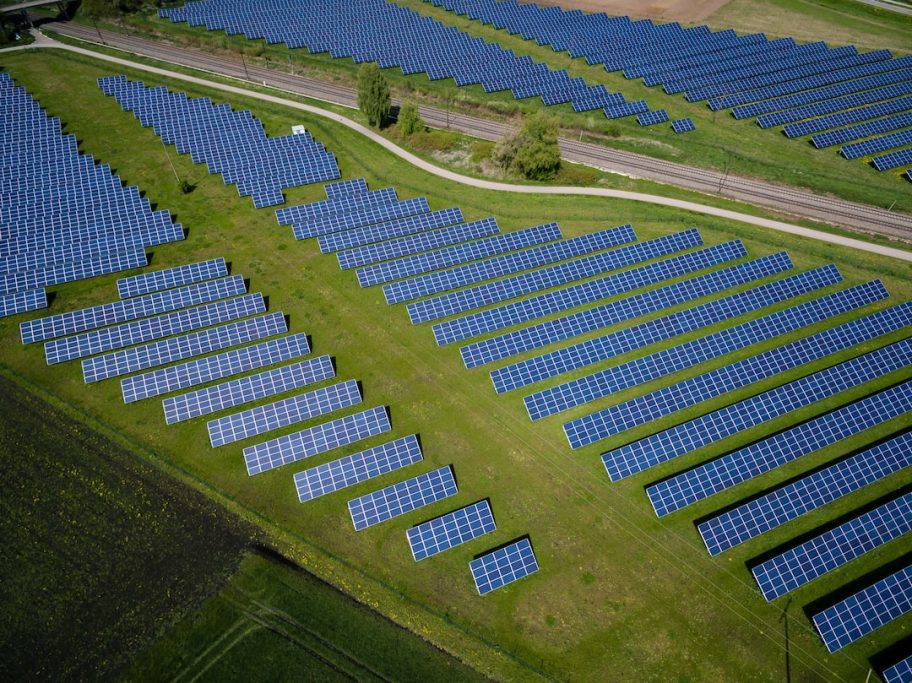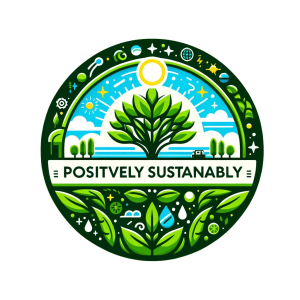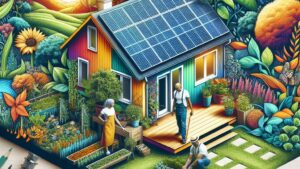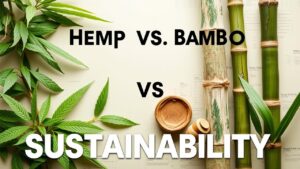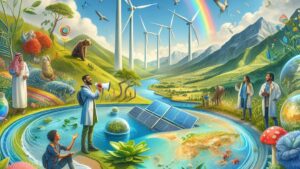Living off the grid can be a rewarding experience, but it also comes with its own set of challenges. One challenge is finding sustainable sources of energy that don’t harm our environment. Fortunately, green energy offers an eco-friendly solution for those looking to reduce their environmental footprint and power their homes in an efficient manner. From solar panels to wind turbines and hydroelectricity systems – there are plenty of ways you can tap into renewable green energy resources for your off-grid living needs. Let’s explore some key benefits associated with utilizing green energy solutions as well as different types of clean technologies available today!
Table of Contents:
- Solar Energy
- Wind Energy
- Hydroelectricity
- Geothermal Energy
- Biomass and Biofuels
- FAQs in Relation to Green Energy
- Conclusion
Solar Energy
Solar energy is a renewable and clean source of energy that can be used to generate electricity or heat. It is one of the most cost-effective and widely available forms of green energy, with many benefits including reducing carbon emissions, providing clean and reliable power, and being relatively easy to install.
Benefits of Solar Energy: One major benefit of solar energy is its ability to reduce our reliance on fossil fuels such as coal, oil, and natural gas. This reduces our dependence on non-renewable sources which are finite in supply. Additionally, solar energy does not produce any air pollution or greenhouse gases like other traditional sources do. This makes it an ideal choice for off-griders who want to stay away from the grid but still have access to clean power. Furthermore, solar panels require minimal maintenance once installed making them very convenient for those living in remote areas where access to repair services may be limited or nonexistent.
Types of Solar Panels: There are two main types of solar panels – monocrystalline silicon (mono) cells and polycrystalline silicon (poly) cells – each with their own advantages depending on your needs. Mono cells are more efficient than poly cells but also tend to be more expensive; however they take up less space so if you’re looking for a smaller installation then mono might be the better option for you. Poly cells offer good efficiency at a lower price point so if budget is your primary concern then this could be the way forward for you instead.
Solar energy is a great way for off-griders to become more sustainable and reduce their environmental impact. Wind energy offers another alternative for those looking to take advantage of renewable sources of power.
Wind Energy
Wind energy is a renewable and clean source of energy that can be used to generate electricity or mechanical power. It has many advantages, such as being cost-effective, having no fuel costs, and being relatively easy to install.
Benefits of Wind Energy: Wind energy is an environmentally friendly source of power because it does not produce any air pollution or hazardous waste. Additionally, wind turbines require minimal maintenance compared to other sources of energy generation like coal plants. Furthermore, wind turbines are able to capture more energy than solar panels due to their larger size and higher efficiency rates. Lastly, the use of wind turbines can help reduce dependence on fossil fuels which helps combat climate change by reducing greenhouse gas emissions.
Types of Wind Turbines: There are two main types of wind turbines; horizontal axis and vertical axis turbines. Horizontal axis turbines have blades that rotate around a central hub while vertical axis ones have blades that spin in a circular motion along the ground surface. Both types come in different sizes depending on the amount of power needed for a particular application but generally speaking they range from small residential models up to large commercial scale installations with hundreds or even thousands of megawatts capacity each year.
Generally speaking, most residential-sized systems will start at around $10,000 USD while larger commercial scale projects may reach upwards into the millions depending on complexity and scope involved in the installation process itself.
Wind energy is a clean, renewable source of power that can help off-griders reduce their reliance on traditional sources of energy. By harnessing the power of water with hydroelectricity, we can further increase our sustainability and reduce our environmental impact.
Hydroelectricity
Hydroelectricity is a renewable energy source that uses water to generate electricity or mechanical power. It has many advantages such as being clean and efficient, having no fuel costs, and providing reliable power in remote areas where other sources are not available.
Benefits of Hydroelectricity: One of the main benefits of hydroelectricity is its ability to produce large amounts of energy with minimal environmental impact. This type of energy does not require any burning of fossil fuels which means it produces no air pollution or greenhouse gases. Additionally, since it relies on gravity rather than combustion, hydroelectric plants have a much higher efficiency rate than traditional thermal power plants. Furthermore, this form of energy production can be used for both small-scale applications such as powering homes and larger-scale projects like generating electricity for entire cities.
Types Of Hydroelectric Power Plants: There are several types of hydroelectric power plants including run-of-the river systems, pumped storage systems, tidal barrages and wave farms. Run-of-the river systems use the natural flow from rivers to generate electricity while pumped storage systems store excess electrical energy by pumping water up into reservoirs during times when demand is low so that it can be released back down again during peak hours when demand is high. Tidal barrages capture the kinetic energy from tides while wave farms use waves generated by wind to create electricity through turbines placed underwater near shorelines.
The cost associated with installing a hydroelectric plant depends on various factors such as size and location but typically ranges between $1 million – $2 million per megawatt (MW). However, once installed these facilities often have very low operating costs due to their high efficiency rates making them an attractive option for those looking for long term sustainability solutions without incurring large upfront expenses.
Hydroelectricity is a renewable energy source that provides clean and reliable power, making it an attractive option for off-griders. Geothermal energy is another form of renewable energy with its own unique benefits and considerations.
Geothermal Energy
Geothermal energy is a renewable source of power that utilizes the Earth’s internal heat to generate electricity or mechanical power. It has many advantages, such as being clean and efficient, having no fuel costs, and providing reliable power in remote areas where other sources are not available.
Benefits of Geothermal Energy: Geothermal energy is one of the most environmentally friendly forms of energy production because it does not produce any air pollution or greenhouse gases. Additionally, geothermal systems can be used for both heating and cooling applications which makes them very versatile. Furthermore, geothermal systems require minimal maintenance since they do not have moving parts like traditional HVAC systems do. Finally, geothermal systems can provide reliable power even during extreme weather conditions when other sources may fail due to their underground location.
Types of Geothermal Systems: There are two main types of geothermal systems – direct use and electric generation (also known as geo-exchange). Direct use involves using hot water from an underground aquifer directly for various applications such as space heating or agricultural processes without generating electricity first. Electric generation uses steam from underground reservoirs to drive turbines that generate electricity at a central plant before distributing it through transmission lines to consumers.
The cost associated with installing a geothermal system depends on several factors including the size and type of system needed as well as local labor rates and material costs. Generally speaking, installation costs tend to be higher than those associated with traditional HVAC systems but lower operating costs over time make up for this initial investment in most cases. Additionally, there are often incentives available from federal or state governments that can help offset some upfront expenses, making it more affordable for homeowners looking into this form of renewable energy production.
Geothermal energy is a great option for off-griders looking to make their homes more sustainable, and it offers many benefits in terms of cost savings and environmental friendliness. The next heading looks at biomass and biofuels, another form of green energy that can be used for sustainability.
Biomass and Biofuels
Biomass and biofuels are renewable energy sources that can be used to power off-grid homes. Biomass is organic material such as wood, agricultural waste, or animal manure that has been converted into a fuel source. Biofuels are fuels derived from biomass materials such as vegetable oils or animal fats. Both of these energy sources have several benefits for off-griders looking to reduce their reliance on traditional fossil fuels.
a. Benefits of Biomass and Biofuels:
The primary benefit of using biomass and biofuel is that they are both renewable energy sources with low environmental impact when compared to traditional fossil fuels like coal and oil. They also require minimal maintenance since they do not need refueling like other forms of energy production such as nuclear power plants or wind turbines do. Additionally, biomass and biofuel can provide an alternative form of income for farmers who use it in their operations by selling the excess fuel produced on their land at market prices instead of relying solely on crop yields alone.
b. Types of Biomass and Biofuels:
There are many different types of biomass available for use, including wood chips, sawdust, agricultural waste (such as corn stalks), paper products (like cardboard boxes), grass clippings, leaves, straws, and nut shells. These can all be burned directly in boilers or furnaces to produce heat for heating water or buildings. Liquid biofuels include biodiesel made from vegetable oils (such as soybean oil) or animal fats (like lard). There is also biogas which is created through the decomposition process when organic matter breaks down without oxygen present; this gas can then be captured in tanks where it is processed into methane before being burned in engines to generate electricity or used directly for cooking purposes depending on its quality level after processing.
FAQs in Relation to Green Energy
What do you mean green energy?
Green energy is the term used to describe renewable sources of energy, such as solar, wind, geothermal and hydroelectric power. These sources are sustainable because they do not deplete resources or cause pollution like traditional fossil fuels. Green energy can be used to generate electricity for homes and businesses, heat water and air in buildings, provide transportation fuel alternatives and more. It is a cost-effective way to reduce emissions while providing clean power that will last indefinitely with proper maintenance. Green energy is an important part of a sustainable lifestyle, and it can help to reduce our dependence on fossil fuels.
What are 3 examples of green energy?
1. Solar Energy: Solar energy is the most widely used form of renewable energy, harnessing sunlight to generate electricity or heat homes and businesses. It can be used in both small-scale applications such as rooftop solar panels, or large-scale installations like utility-scale solar farms.
2. Wind Energy: Wind turbines use the kinetic energy from wind to generate electricity without emitting any pollutants into the atmosphere. This clean source of power has become increasingly popular for its low cost and scalability, making it an attractive option for many homeowners and businesses alike.
3. Hydropower: Hydropower uses water flowing through a turbine to generate electricity with no emissions involved in the process at all. Large dams are often built on rivers to create reservoirs that store water which is then released when needed, powering hydroelectric generators downstream along its course.
What is green energy and how does it work?
Green energy is a type of renewable energy that comes from natural sources such as sunlight, wind, rain, tides and geothermal heat. It is considered to be an environmentally friendly alternative to traditional fossil fuels like coal and oil. Green energy works by harnessing the power of these natural elements in order to generate electricity or other forms of usable energy. For example, solar panels use the sun’s rays to create electricity while wind turbines capture kinetic energy from the air flow and convert it into mechanical power. Other green technologies include hydroelectric dams which capture water pressure for generating electricity and geothermal plants which extract heat from underground reservoirs for heating purposes.
Why is it called green energy?
Green energy is a term used to describe renewable sources of energy that are environmentally friendly and do not cause pollution. Examples include solar, wind, geothermal, hydropower, and biomass. These sources of energy are considered green because they produce no greenhouse gases or other pollutants when generating electricity. Additionally, these renewable sources can be replenished naturally without the need for additional resources or materials. This makes them an ideal choice for off-griders who want to live sustainably while still having access to reliable power.
Conclusion
In conclusion, green energy is an important and viable option for off-griders looking to become more sustainable. With the many options available such as solar, wind, hydroelectricity, geothermal and biomass/biofuels there are plenty of ways to make your home or business more eco-friendly. Investing in green energy can help reduce carbon emissions while also saving you money on your utility bills. By investing in renewable sources of energy like these you can be sure that you’re doing your part to protect our planet for future generations. Green energy is a great way to ensure a brighter future!
It is time for us to come together and take action towards creating a more sustainable future. We need to focus on green energy solutions that can reduce our reliance on non-renewable resources, decrease emissions, and help combat climate change. By investing in renewable sources of energy like solar power, wind turbines, geothermal systems and hydroelectricity we can make the world cleaner while saving money in the long run. Let’s work together now to create positive change for generations to come!

